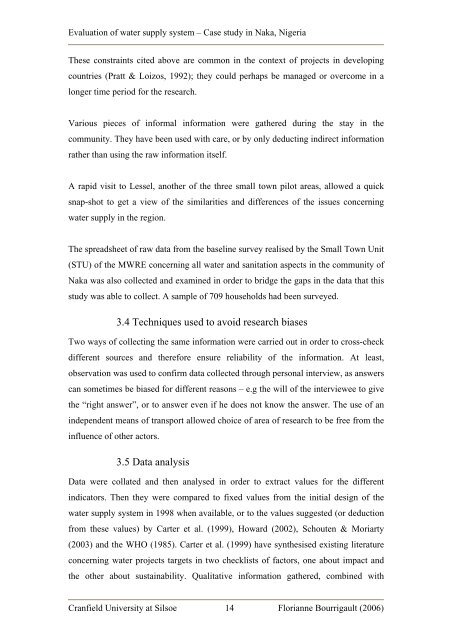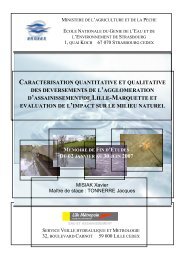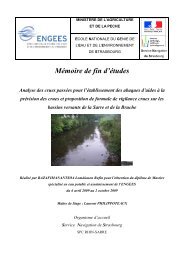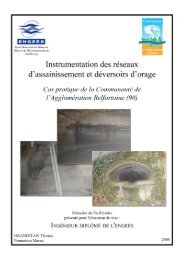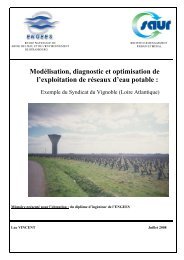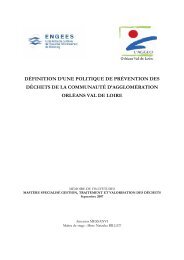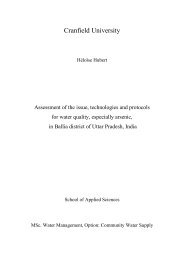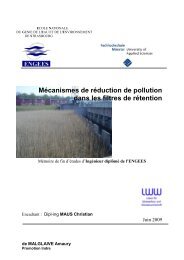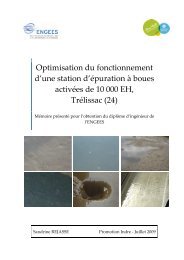Evaluation of water supply system Case study in Naka ... - ENGEES
Evaluation of water supply system Case study in Naka ... - ENGEES
Evaluation of water supply system Case study in Naka ... - ENGEES
- No tags were found...
Create successful ePaper yourself
Turn your PDF publications into a flip-book with our unique Google optimized e-Paper software.
<strong>Evaluation</strong> <strong>of</strong> <strong>water</strong> <strong>supply</strong> <strong>system</strong> – <strong>Case</strong> <strong>study</strong> <strong>in</strong> <strong>Naka</strong>, NigeriaThese constra<strong>in</strong>ts cited above are common <strong>in</strong> the context <strong>of</strong> projects <strong>in</strong> develop<strong>in</strong>gcountries (Pratt & Loizos, 1992); they could perhaps be managed or overcome <strong>in</strong> alonger time period for the research.Various pieces <strong>of</strong> <strong>in</strong>formal <strong>in</strong>formation were gathered dur<strong>in</strong>g the stay <strong>in</strong> thecommunity. They have been used with care, or by only deduct<strong>in</strong>g <strong>in</strong>direct <strong>in</strong>formationrather than us<strong>in</strong>g the raw <strong>in</strong>formation itself.A rapid visit to Lessel, another <strong>of</strong> the three small town pilot areas, allowed a quicksnap-shot to get a view <strong>of</strong> the similarities and differences <strong>of</strong> the issues concern<strong>in</strong>g<strong>water</strong> <strong>supply</strong> <strong>in</strong> the region.The spreadsheet <strong>of</strong> raw data from the basel<strong>in</strong>e survey realised by the Small Town Unit(STU) <strong>of</strong> the MWRE concern<strong>in</strong>g all <strong>water</strong> and sanitation aspects <strong>in</strong> the community <strong>of</strong><strong>Naka</strong> was also collected and exam<strong>in</strong>ed <strong>in</strong> order to bridge the gaps <strong>in</strong> the data that this<strong>study</strong> was able to collect. A sample <strong>of</strong> 709 households had been surveyed.3.4 Techniques used to avoid research biasesTwo ways <strong>of</strong> collect<strong>in</strong>g the same <strong>in</strong>formation were carried out <strong>in</strong> order to cross-checkdifferent sources and therefore ensure reliability <strong>of</strong> the <strong>in</strong>formation. At least,observation was used to confirm data collected through personal <strong>in</strong>terview, as answerscan sometimes be biased for different reasons – e.g the will <strong>of</strong> the <strong>in</strong>terviewee to givethe “right answer”, or to answer even if he does not know the answer. The use <strong>of</strong> an<strong>in</strong>dependent means <strong>of</strong> transport allowed choice <strong>of</strong> area <strong>of</strong> research to be free from the<strong>in</strong>fluence <strong>of</strong> other actors.3.5 Data analysisData were collated and then analysed <strong>in</strong> order to extract values for the different<strong>in</strong>dicators. Then they were compared to fixed values from the <strong>in</strong>itial design <strong>of</strong> the<strong>water</strong> <strong>supply</strong> <strong>system</strong> <strong>in</strong> 1998 when available, or to the values suggested (or deductionfrom these values) by Carter et al. (1999), Howard (2002), Schouten & Moriarty(2003) and the WHO (1985). Carter et al. (1999) have synthesised exist<strong>in</strong>g literatureconcern<strong>in</strong>g <strong>water</strong> projects targets <strong>in</strong> two checklists <strong>of</strong> factors, one about impact andthe other about susta<strong>in</strong>ability. Qualitative <strong>in</strong>formation gathered, comb<strong>in</strong>ed withCranfield University at Silsoe 14 Florianne Bourrigault (2006)


